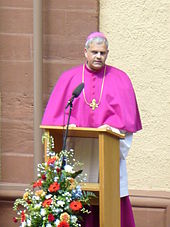Auxiliary bishop
Auxiliary bishop is the common name in German-speaking countries for the office of auxiliary bishop (from Latin episcopus auxiliaris , auxiliary bishop) in many Catholic dioceses .
history
Bishops whose diocesan territory had been conquered by non-Christian rulers and who had to leave their bishopric retained their title. These bishops sought refuge with a bishop in a Catholic area, who then frequently appointed them as deputies. Auxiliary bishops as deputies of the diocesan bishop were established at the Council of Vienne (1311/12). They were consecrated to titular dioceses that were no longer in the Catholic sphere of influence. Since the 16th century these dioceses were called partibus infidelium ("in areas of the unbelievers"). Furthermore, a bishop who - which was not uncommon in the Middle Ages - lacked church ordinations, had to be assigned auxiliary bishops to perform ordinations.
Sacramental status
An auxiliary bishop is a bishop by degree of ordination . However, he does not lead a diocese, but is assigned to a diocesan bishop as an assistant in the episcopal functions. Since the office of bishop is theologically related to the leadership of a particular church, the auxiliary bishop is ordained to the title of a lost diocese ( titular bishop ).
service
There are auxiliary bishops in dioceses in which, due to their personal or geographical size, the specific episcopal tasks cannot be carried out by the diocesan bishop alone. The auxiliary bishop represents him primarily in the acts of consecration ( church consecration , deacon consecration ) and in the dispensing of the company sacrament . As a visitor he also takes part in the pastoral service.
The vicar general is the representative of the resident bishop in the field of administration and jurisdiction . Frequently, however, auxiliary bishops are also appointed by the diocesan bishop as episcopal vicars with a specific area of responsibility; occasionally they are also called to the office of vicar general.
A special feature is the possibility of appointing an auxiliary bishop to control a bishop who cannot simply be removed from office. In canon 403, paragraph 2, it says: "In the presence of more serious circumstances, including personal ones, the diocesan bishop can be given an auxiliary bishop who is endowed with special powers."
Auxiliary bishops are members of the cathedral chapter and the regional bishops' conference .
Like a diocesan bishop, an auxiliary bishop, at the age of 75, submits his resignation, which is usually accepted. Like the diocesan bishop, however, he retains his (titular) bishopric after his retirement .
The number of auxiliary bishops depends on the size and needs of the diocese and is determined by the diocesan bishop in agreement with the apostolic see .
insignia
Like all Catholic bishops, the auxiliary bishops wear a violet cassock and a violet mozetta as choir clothing , with a pectoral cross on it and a bishop's ring on the hand . When leading an episcopal mass, they use the pontifical miter , crosier and pectoral .
Title
In order to distinguish the titular bishop acting as auxiliary bishop in a diocese from the diocesan bishop, it is said: NN Bishop of [name of titular bishopric ], bishop in [name of diocese in which he is appointed auxiliary bishop]. The prefixes consecrated or titular are actually not used in protocol, as there is no difference in the degree of consecration to the diocesan bishop (see above, sacramental status ).
literature
On the legal and sacramental status:
- Codex Iuris Canonici (1983), can. 403-411
- Norbert Ruf : The right of the Catholic Church . Freiburg 1989, p. 122 f.
About history:
- Adolf Adam , Rupert Berger : Pastoral-liturgical hand dictionary . 5th edition. Freiburg 1990, p. 67
- Michael F. Feldkamp : Why did the German dioceses, which were secularized in the confessional age, not give rise to titular dioceses? Observations on the development of the legal institute of the titular bishop. In: Andreas Gottsmann, Pierantonio Piatti, Andreas E. Rehberg (eds.): Incorrupta monumenta ecclesiam defendunt. Studi offerti a mons. Sergio Pagano, prefetto dell'archivio segreto vaticano. 1: La Chiesa nella storia. Religione, cultura, costume (= Collectanea Archivi Vaticani. 106). Volume 1. Archivio Segreto Vaticano, Citta del Vaticano 2018, ISBN 978-88-98638-08-6 , pp. 589-606.


